The longer, brighter days of March brought new life to the Priory. A kingfisher is an occasional visitor, as are mandarin ducks; and tree-creepers are a new notch in my bird-watching stick. But all three are ultra shy and impossible to photograph. Yet.
With the grass growing, canada geese returned.
They don’t stay long; just gobble a bit of lawn, defecate profusely and then announce their imminent departure by loud, prolonged honking. Still honking, they hoist themselves into the air and fly off somewhere altogether better – presumably – leaving the garden a little emptier; a lot quieter. Perhaps they’ll return to breed but they haven’t in the past.
Last week saw another new species in the garden … which I was able to photograph. Not the dunnock on the left – obviously – but its companion: a reed bunting.
I only knew what she was, because of her distinctive mate.
Reed buntings increasingly visit gardens to feed: these two were foraging beneath the feeders. With reedmace spreading through shallow water in the ponds, I wonder whether they will stick around and build a nest. They could choose a worse home.
The snowdrops and crocuses went over during March as Cyclamen coum reached a quiet peak. The handful I planted are spreading nicely.
Of the 100’s of daffodils I’ve added, February Gold are amongst the most successful. (This won’t be news – I tell you the same every year. It’s almost a tradition).
But after last year’s surprise February flowering, and as we head into April, they’re back to their usual tardy, malingering ways.
Primroses are everywhere;
on the bank below the greenhouses,
with the first couple of wood anemones;
and springing up in areas of lawn I leave uncut.
There are even a few coloured primroses. They came, unwanted, from a garden I once worked in and, though I didn’t particularly want them either, I didn’t have the heart to chuck them out. They’re OK, I suppose.
But when the common or garden yellow is so very perfect, I see no need for blue or mauve.
The first fritillary has emerged on the meadow. I’m hoping to show you many, many more.
But as the Priory sits deep in Jack Frost’s pocket, there still isn’t an awful lot happening.
On the last day of March, as I stood out on the meadow – grumbling at how poorly various daffodils are performing (it’s too soggy, I now realise) – my eyes drifted off to the six weeping willows by the west pond.
The sun lit up the new leaf and, in a hearty breeze, they waved and drew me over.
When more leaf unfurls they’ll look better still.
No-one’s ever said to me, “David, you simply must come into the garden and see my dancing weeping willows.” Maybe they feared my reaction? But the long drooping branches did sway and shimmer beautifully: it was beguiling to watch … if difficult to convey in a couple of photos.
This might be better? But to see them properly, one blustery March day next year, you simply must come into the garden and see my dancing weeping willows.
Now that’s something no-one’s ever said to you before.



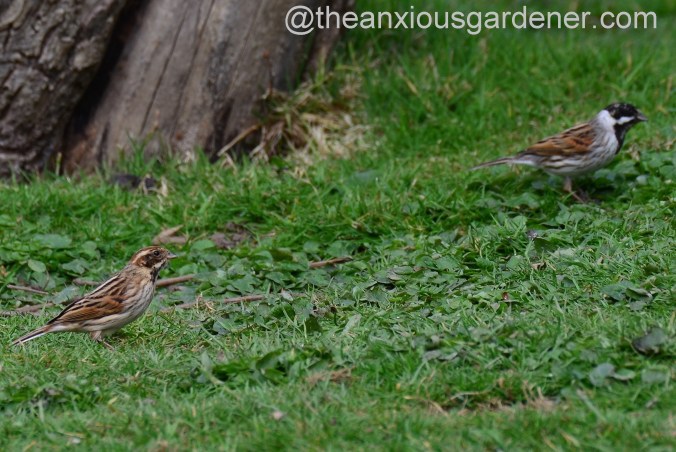

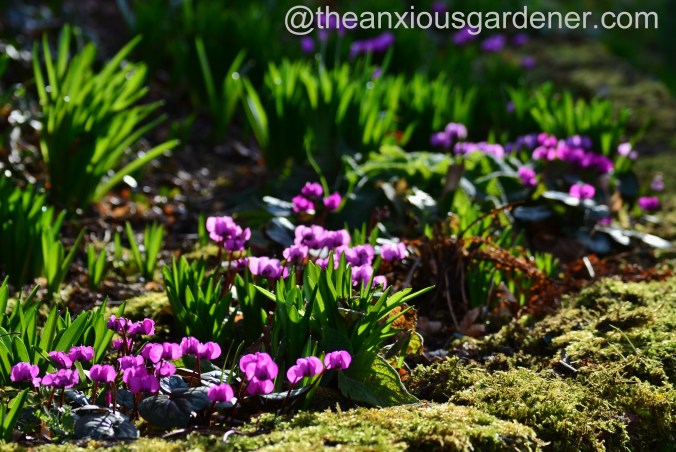




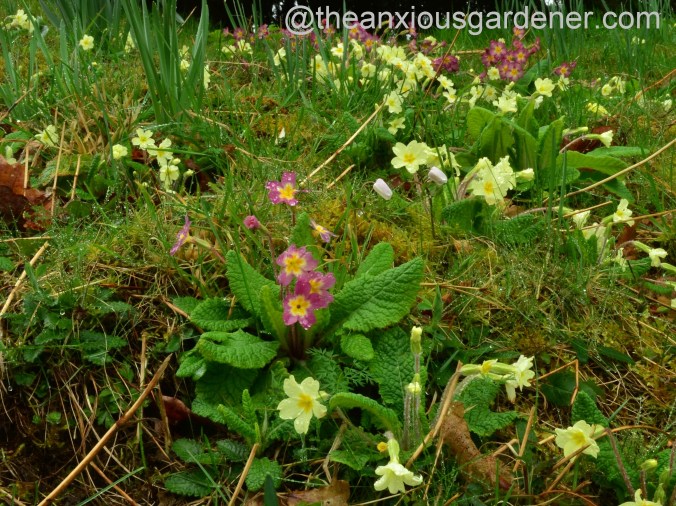

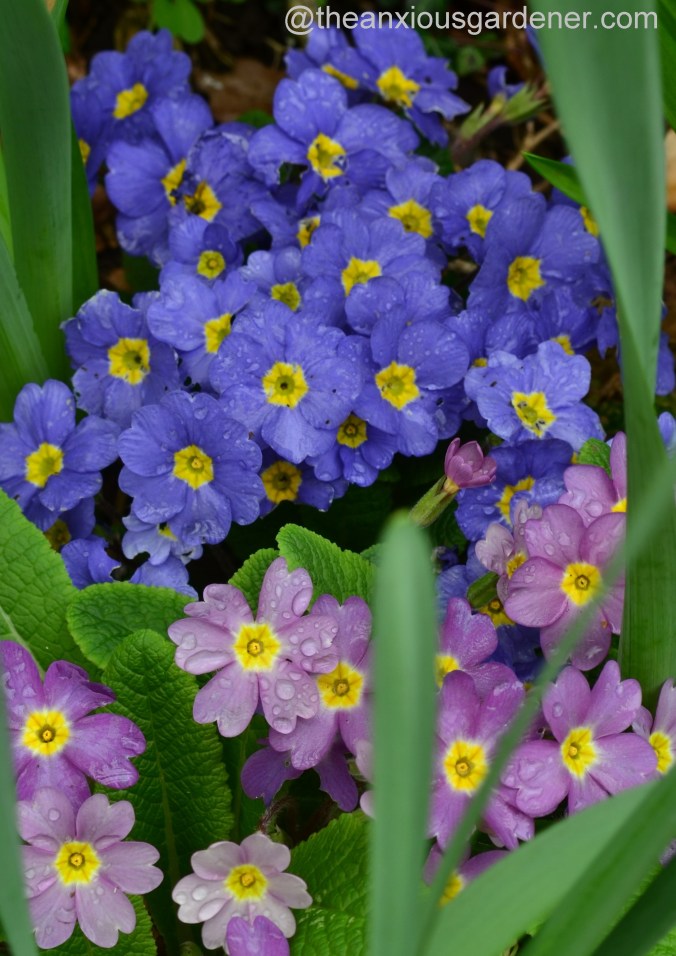

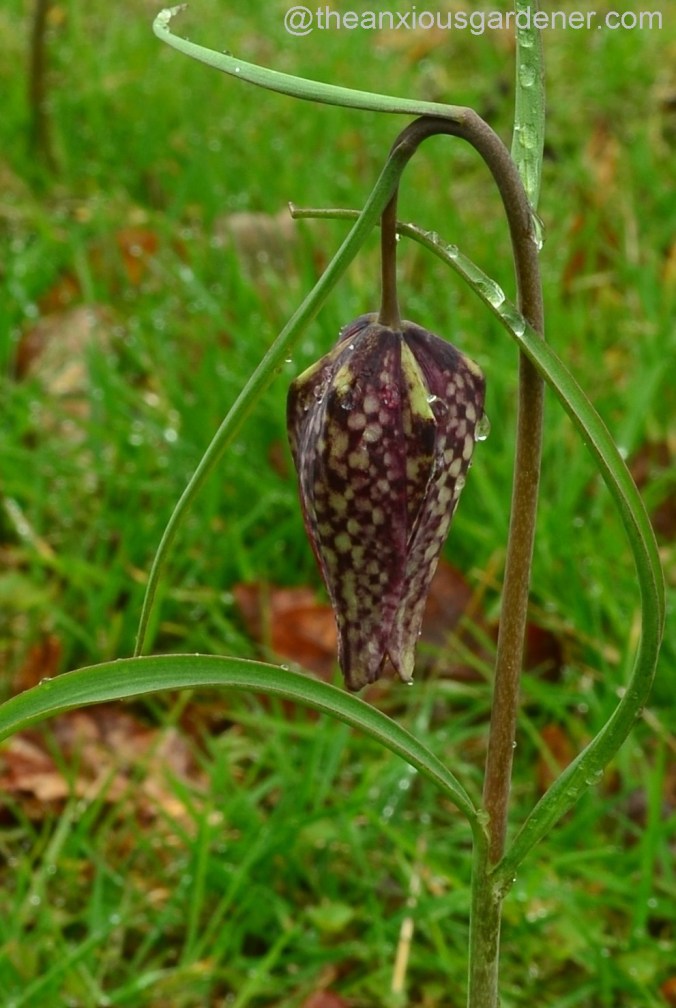

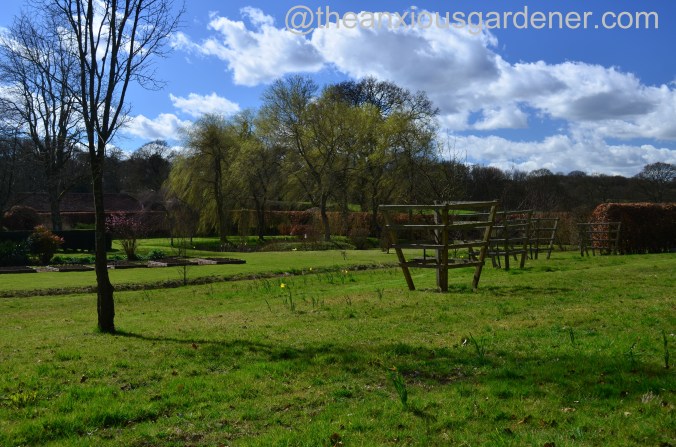

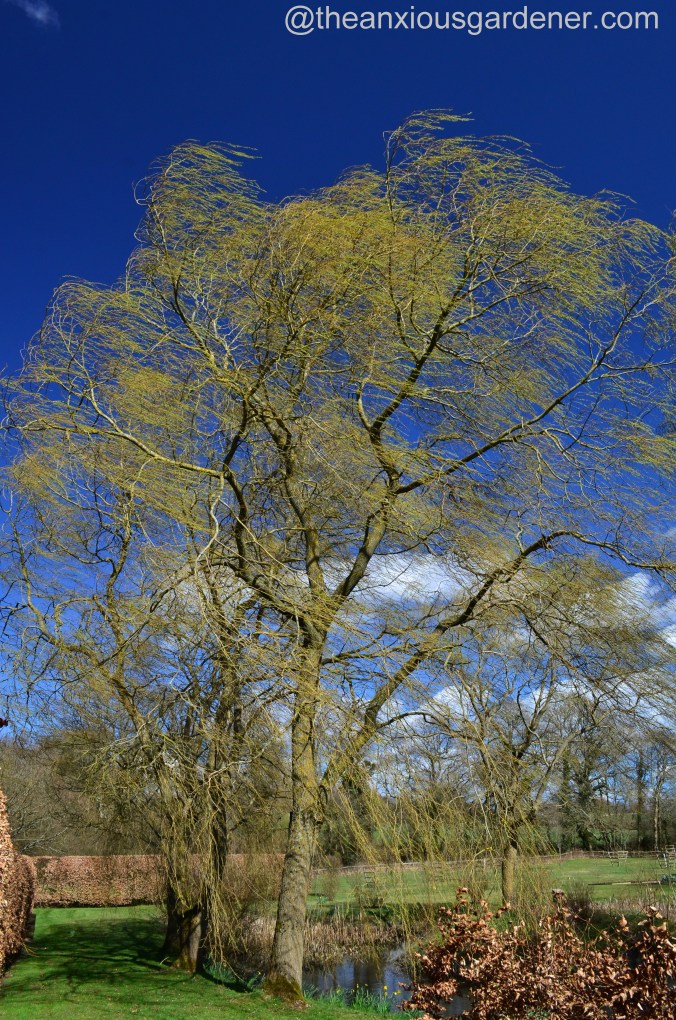

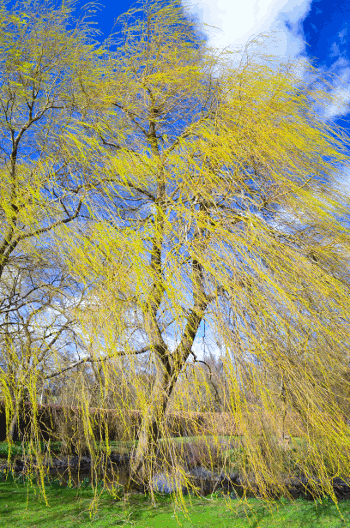
Compared to my garden, you have a lot blooming, David. thanks for all the cheerful pictures.
I’ll have to make that of that particular daffodil.
I love weeping willows, especially by a stream or pond. we had a few at our last place and it’s such an elegant, mysterious sight.
Sorry about the Canada Geese — I hope they are my country’s only such rude export.
LikeLike
No need to apologise, Cynthia. Some people consider canada geese a pest but so long as they behave as they are doing, I’m happy to have them. But since you ask, would you please take Justin Bieber back? Ta. Dave
LikeLiked by 1 person
No, no. We gave you all Justin Bieber and it’s bad form to return such a lovely gift, David! (Wink, smile)
LikeLiked by 1 person
Sigh. Well, I had to ask.
LikeLiked by 1 person
Thank you for the beautiful weeping willows. I was stuck in slow-moving traffic on the motorway the other day and was captivated by some glowing weeping willows at the side of the road, so you are definitely not alone in appreciating their beauty.
Great blog.
LikeLike
Hi Rej, thanks. After I wrote this post, I did notice willow green far more as I drive about Sussex. It sounds from these comments, it is far more appreciated than I had supposed. I thought it was just me! It’s often a hunting kestrel that keeps me occupied when stuck in traffic. Thanks for commenting. Dave
LikeLike
Love the daffs and the wild primroses are impossible to beat, but the stars are clearly your dancing willows, what a glorious sight against the blue sky.
The reed bunting is a little beauty, but I confess I have a soft spot for the honking geese, they always make me smile. That could change if they decided to defecate all over my grass though, it would fertilise the sycamore seedlings, not that they need any encouragement. At least when they grow in the grass the mower puts paid to their attempts at world domination. As for fritillaries, I have two! That’s one more than last year, so who knows, maybe in twenty years I will have a drift… Enjoy spring, and your attempts to gain photographic proof of your more elusive feathered visitors!
LikeLike
Hi Janet, the geese were back yesterday – same noisy routine. I don’t know why they don’t nest-build though perhaps the garden aesthetic isn’t to their taste. But it’s the kingfisher I really want to catch on camera. I only ever get a distant flash of ‘those’ colours so I’ll need to be very lucky. I suffer from fritillary expectation every year. I don’t suppose the blanket colony I envisage will happen until long after I’ve moved on … but I can hope. Congrats on your second fritillary. 4 next year, 8 the following? Dave
LikeLike
Yet another thing I miss about (…thinks of synonyms for soggy…) moist climates is weeping willows. There are a few, of course, in places where people are willing to use enormous amounts of extra water, but there really shouldn’t be any. (Because no one in the desert should be using that much extra water!) So no dancing here, alas. Our spring has departed early–like your Canada geese, only without the honking.
LikeLike
That anyone would water fully grown weeping willows (in a desert!!) is fairly astonishing … and frankly quite mad. But then I guess ‘they’ build golf courses in deserts too. You’d like the honking, Stacy. It’s so polite of the geese to keep me informed as to their intentions. Dave
LikeLiked by 1 person
Hurrah for self-sowing primroses, and cyclamen coum; spring flowers look so stunning en masse, rewarding the patient gardener! Both spread here too which gives me great pleasure…
I’ve been admiring the bright new foliage on willows down by the river here today too, so beautiful as it emerges!
LikeLike
Hi Sara, I should think you are far too busy with the new arrival for standing about admiring things! Spring seems to have taken a long time coming … but then it always does. At the same time it’s taken me a little by surprise and I’ve still so much to do. No change there either. D
LikeLike
Ha indeed, he only sleeps in the car or when I put him in a wrap or sling and go for a walk – so the old ‘sleep when the baby sleeps’ adage doesn’t quite work, ha ha, but at least it gets me out and about most days so I do have a fair few chances to stand and admire. Well, admire at least. He tends to dig his feet into my sides if I stand still for long. It’s a horrible tease to walk around our garden though – I see all the jobs that I need to get on with, but have no opportunity for – he won’t even let me work a spade with him strapped to me – I’ve tried!
Are you still coming out this way to the borders this spring for your walkabout?
LikeLike
Digging with a baby strapped to you? How very Breughel! Sounds like standing and admiring is your limit after all but then life could be worse!? And sadly, no on the walking front. My annual Big Walk has had to be sidelined this year as I have various other travel commitments. I’m planning on doing a couple of walks but nothing as exciting as Offa’s or the Pennine Way, Sadly. But next year? Dave
LikeLiked by 1 person
To find beauty in the mundane is a gift. Thank you for sharing your dancing willows. Enchanting
LikeLike
Glad you liked it Rosemary.
LikeLike
It all looks so lovely. Not a lot happening here, still too cold in Lancashire but lots of promise of things to come.
LikeLike
Hi Dan, hang on in there … it’s coming! D
LikeLike
I love the happy smiling faces of the violas. Your primrose bank is an iconic welcome to spring. I am still waiting to see them appear on the railway banks on the Brighton line when I go to work.
LikeLike
Hi Ronnie, I only planted up the violas a few days ago and they don’t fill the pots enough yet – but I was struggling to find stuff to photo! Hope your commute is lit up soon. D
LikeLiked by 1 person
Beautiful! I love spring and your Priory is gorgeous! I’m a huge fan of the migrating geese and swans that migrate through my area. The farmers leave potatoes and squash for them to gobble down for their migration. I watched a group in a potato field once and it was so funny watching them swallow a whole potato! It’s a fowl airport! https://www.youtube.com/watch?v=sEWqxjGPmug
LikeLike
That is an amazing piece of film, Sheri. I was trying to imagine my reaction if a flock that size were to descend on the Priory! Fall over, I suspect. D
LikeLike
We have a saying here, “Don’t work with your tongue sticking out, a bird might poop on it!”
LikeLike
Now that is a saying I shall adopt immediately. D
LikeLike
Our area lost many weeping willows during Hurricane Gloria in 1985; the bigger they were, the sooner they were toppled. I once had a silver willow (Salix alba ‘Sericea’) and loved the silver foliage — always thought that if there were a weeping variety it would look spectacular planted next to a “normal” weeping willow — silver and gold in spring!
LikeLike
I can imagine a weeping willow acting like a perfect sail in a hurricane. I’ve just looked up images of the silver willow. Very beautiful, rather like white poplar. I wonder whether I could squeeze one in. D
LikeLiked by 1 person
I put mine in a damp spot created by runoff from my endlessly-watering neighbor’s yard; in 9 years it went from a 12″ sapling to about 17 ft tall, and sucked up all that extra moisture happily!
LikeLiked by 1 person
The willows look beautiful. I used to have a large weeping willow in a garden I once had. The problem was people always admired it immensely and never looked at anything else and I’ve never felt the same about them since. You don’t have that problem as they are well-balanced in your huge grounds. I love the primroses. Mine are getting out of control in the borders so I have now got a good idea to where I can re-site them. Amelia
LikeLike
Hi Amelia, I forget how big the grounds are sometimes. It is easy to barely notice the willows – which given their size is a little surprising. I don’t think they’re that old actually and will grow much bigger – especially since we removed competing alders. It’s lovely to see primroses spreading throughout the gardens here. And I wonder just how many there will be in another 10 or 20 years. D
LikeLiked by 1 person
We have several weeping willows growing around this area, I always think their foliage is very striking.
If I had a big enough garden I would certainly grow one, then visitors could come and see my dancing weeping willows.
LikeLike
Hi Brian, I suppose blithely saying “the six weeping willows by the west pond” does show just how big the Priory is. The owner wanted me to plant more around the east pond too but I think six is enough. However much I might love them dancing about the place, you can have too much of a good thing. Dave
LikeLike
Ps. Love the animated willow. How did you get it in there?
LikeLike
Hi Charles, I made the GIF using a dozen shots taken with the shutter in continuous burst mode (should’ve used my tripod actually). Then merged them together using GIMP – a free editing suite. It’s a little fiddly but quite easy. Dave
LikeLike
Sounds fiddly. Could you not have shot a video clip? BTW is yours full frame or are you getting effectively an even longer zoom than the 300 max?
LikeLike
I did take a couple of videos actually but what I like about GIF’s is that they just sit in the post and do their thing. No need to click to watch, which I think some readers might not bother to do. No, my Nikon D7000 isn’t full frame. What do you mean by “are you getting effectively an even longer zoom than the 300 max?” The photos of birds above are cropped which probably makes them look like I was closer than I was. D
LikeLike
Get those washed out primulas out of that meadow. They are horrid. Said with love.
LikeLike
I can send them to you if you like?
LikeLike
It’s what compost heaps are for 😉
LikeLiked by 1 person
The yellow ones are so much nicer.
LikeLike
Yep!
LikeLike